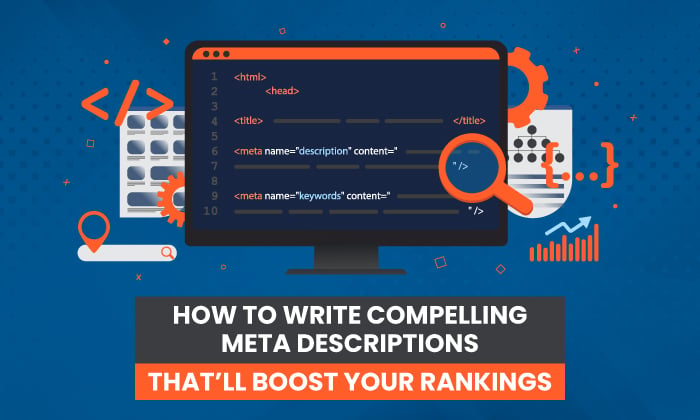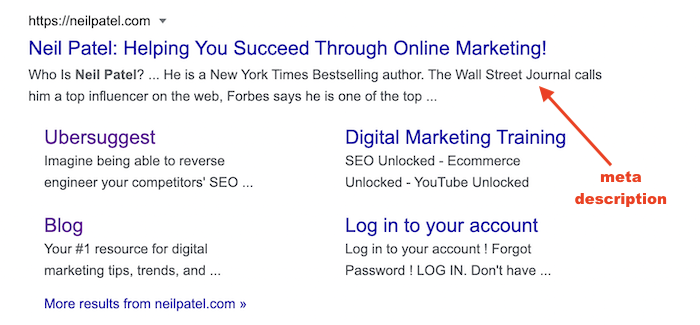
If you’re looking to increase your organic SEO rankings, meta descriptions might be the answer.
That is, if they are written well!
A great meta description should compel users to click on your page in the search results to learn more.
It should also contain keywords to boost your SEO.
Below, we’ll explain the best practices for creating meta descriptions to help you dominate Google search results.
What Are Meta Descriptions?
Meta descriptions are 160-character snippets used to summarize a web page’s content. Search engines display these snippets in search results to let visitors know what a page is about before clicking on it.
Meta descriptions help users decide if they want to click on your website in a search result. They are also an important factor in where your website ranks in the search results.
Below, you can see a quick example of a meta description on our site.

Why Are Meta Descriptions Important?
Meta descriptions are important because meta tags (including meta descriptions) are used by the Google algorithm, which helps determine what pages should rank well for certain keywords.
If you’re using meta descriptions properly, you have an opportunity to add a meta tag that isn’t in your content. This could be the difference between ranking on page four for “best shoes,” or on page one.
Meta descriptions help:
- Increase click-through rates, which in turn will boost your conversions and sales.
- Improve indexing so you rank higher on search engine results pages (SERPs).
- Make it easier for visitors to find the content they’re looking for without scanning page titles or meta tags.
Pages with meta descriptions see an average of 5.8 percent more clicks than pages without.
Even search engine giant Google recommends writing meta descriptions on your site.
On the user-experience side, meta descriptions show searchers what your website is all about and what information they can expect to find if they click.
Meta descriptions can also show up on social media sites when a link is shared.

If a meta description is not present, or if you have written it outside of best practices, a search engine may create one for you. The problem is, it might not be as accurate or compelling as the one you write yourself.
That’s why it’s crucial to write your own meta descriptions.
Tips for Writing Great Meta Descriptions
Meta descriptions are a great way to engage users on the SERP and improve your organic traffic.
How do you write meta descriptions that drive clicks and improve your ranking? Here are eight tips to help you create more compelling meta descriptions.
1. Include a CTA in Your Meta Descriptions
Using a call-to-action (CTA) in your meta descriptions is a great way to compel people to click on your website. You can use phrases like “Learn More” or “Click Here” or “Shop Now,” when they see it come up in SERPs.
CTAs help readers understand what the page offers and what they can expect if they click. They can also give users an incentive for clicking through and engaging with your site.
CTAs can be used to sell a product, offer an email sign-up, or direct readers to your social media pages.
This example from Automattic on LinkedIn asks users to join LinkedIn to apply for their positions.

2. Focus on Value Your Meta Description
Adding words that describe the value you offer is a great way to entice people to click.
When someone reads a meta description, they should be able to understand what is on offer and whether it is worth their time.
Include words like “learn,” “see,” or “watch” when appropriate to interact with your content.
Other words, such as “best,” “deal,” “new” or “popular,” can also make your meta descriptions more compelling.
3. A/B Test Your Meta Descriptions
A meta description is a great place to experiment with different keywords, phrases, or CTAs.
This will help you determine what drives more engagement without doing anything permanent or drastic in your site’s design itself.
You can A/B test your meta descriptions by making two meta descriptions for each page.
One meta description could use one variation of a keyword, phrase, or CTA. The second meta description could be your current meta or focus on a different offer or term.
Run each meta for a few weeks, then check your Google Analytics to see which version earns more clicks. Then, use that information when crafting new meta descriptions.
(If clicks are close, consider looking at other metrics, such as bounce rate, time on page, or conversions. Traffic isn’t the only thing meta descriptions can impact!)
4. Experiment With Character Length
Meta descriptions are limited to 150 characters. Going over this length will result in your meta being truncated in the search results, which means users won’t see any content after the cut-off.
Here’s an example of a truncated meta. Notice the ellipses:
Even though you can’t go over the limit, you can experiment with your description to see what works best for each page. For example, in-depth guides may actually get more clicks with the truncated results because users want to learn more.
You may find shorter meta descriptions work best on your home page, while blogs perform better with a higher word count. Or, you may find meta descriptions with a higher word count work best for your recommended products page.
Try not to exceed the recommended character length, as it can negatively affect your rankings.
5. Make Your Meta Descriptions Unique and Interesting
Meta descriptions provide an overview of what content is contained on a page, so they’re important for attracting readers’ attention.
Try different approaches to grab user attention, such as using a clickbait title or asking a question users want answered.
Try using eye-catching words or phrases that will grab a user’s attention such as “shocking,” “hilarious” or “life-changing.” Just be careful not to overpromise and under-deliver.

As you can see in the example above, they use a very active voice that provides a momentous push for the reader.
You’re told what you can expect but without any unnecessary details. If you’re looking for a simple way to help your SEO, you would most likely click on this link.
You’ll also notice the example above is very specific and doesn’t contain any fluff.
This is especially important if you want to rank high in the SERPs.
Most importantly, make sure the description matches the content of the page.
6. Include Keywords in Your Meta Descriptions
It’s important to include keywords in meta descriptions for two reasons:
- It helps search engines understand the page and better rank your content.
- It reassures users that the page covers the topic they are interested in.
Use a tool like Ubersuggest to find the best keywords for your site. Then, add them to your meta descriptions to improve your ranking.
Note: Each page should use different keywords in the meta descriptions to ensure your page shows up in all relevant searches.
Keep in mind, Google does not use keyword meta tags directly in its rankings. That doesn’t mean they aren’t valuable for users.
Also, avoid keyword stuffing in your meta descriptions or you risk a search engine penalty. Each meta description should contain one or two keywords per phrase and they should be relevant to the page.
7. Implement Structured Data
Structured data meta tags are HTML tags you can add to your website to provide additional context for search engines and social media platforms.
The most common types of structured data meta tags used by marketers are the business name, address, phone number, email address, a product description with price points (if applicable), an image URL and a Twitter handle.
There are plenty of ways you can start implementing structured data.
One of the most popular ways you may have seen is when websites implement reviews in their meta description:

This provides an immediate signal to your viewer that they can find something of value on the site.
Since social proof is such a powerful way to sell and grow your brand, this is a fairly easy hack that lets you start capitalizing on user behavior with ease.
Structured data can help you build a more powerful meta description that will help you rank higher in search results. They can also help you snag Google snippets.
8. Do Not Duplicate Meta Descriptions
A meta description is crucial to ranking, so make sure to write unique meta descriptions for each page. Unique meta descriptions increase the probability that search engines and other browsers can understand what content is on a page and how it compares to other pages.
For example, if a user sees duplicate meta descriptions on every page of your website, they won’t know what kind of content is on what page.
This is especially important for e-commerce sites, which may have several pages with similar content. Even if the products are similar, the metas should be unique.
Duplicate meta descriptions can have negative effects on your website as they make it difficult for meta description crawlers to crawl your site. You may also face indexing penalties because crawlers are not able to determine which page is original.
Examples of Great Meta Descriptions
The best examples of meta descriptions come from search engines themselves. Let’s look at Google’s own meta description for starters.
Here’s the coding for Google’s own meta description:
<meta name=”description” content=”Search the world’s information, including web pages, images, videos and more. Google has many special features to help you find exactly what you’re looking for.“>
It is exactly 159 characters, including spaces. Google’s meta description is displayed as follows in the top three search engines.
In Google:
In Yahoo:

In Bing:
Here are a few branded meta descriptions that do well:
Tesla

Tesla’s meta description quickly and efficiently tells you everything you need to know about the company and its values. The meta description fits perfectly within the SERP and none of the words are cut off.
Lonely Planet

Lonely Planet starts with a question to draw readers in and encourage clicks. From there, they explain their unique value propositions and get you excited about traveling the world!
Meta Descriptions Frequently Asked Questions
How many characters should a meta description be?
A meta description should be approximately 160 characters in length, including spaces, and include a concise but compelling description of the content on that page.
Where does my meta description appear?
Your meta description appears on the search engine page when a user searches for your site’s keyword. It is directly under your meta title.
Do meta descriptions affect SEO?
Yes, meta descriptions affect SEO as they provide search engines with information about your page and impact user experience.
Should my meta description be the same as my page's title or H1?
No. Use unique meta descriptions and meta titles for each page of your website. Remember, the meta description is right under the title, which is generally your H1. Don’t waste that space!
How to Write Meta Descriptions: Conclusion
Meta descriptions are an important part of your onsite SEO. They should be compelling, descriptive, and unique to each page.
Meta descriptions may be short, but they can help you rank higher in search engine results pages (SERPs) by helping search engines and users better understand what your page is about.
Remember to include meta descriptions on every page of your site, including blog posts and product pages.
What tips do you have for creating great meta descriptions?
from Blog – Neil Patel https://ift.tt/2r2wYTN
via IFTTT
No comments:
Post a Comment